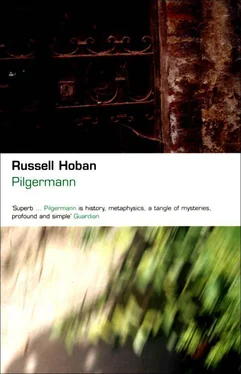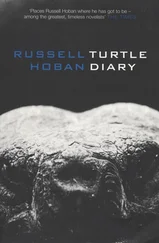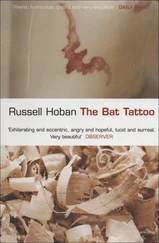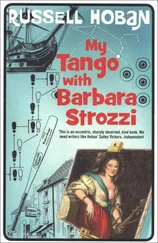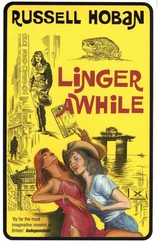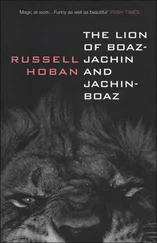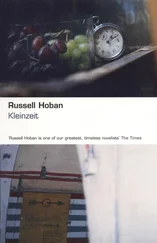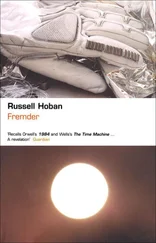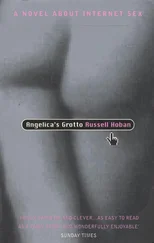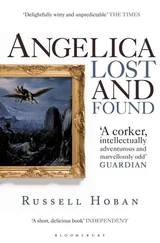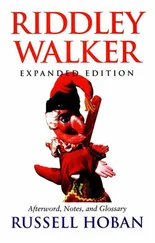Russell Hoban - Pilgermann
Здесь есть возможность читать онлайн «Russell Hoban - Pilgermann» весь текст электронной книги совершенно бесплатно (целиком полную версию без сокращений). В некоторых случаях можно слушать аудио, скачать через торрент в формате fb2 и присутствует краткое содержание. Год выпуска: 2002, Издательство: Bloomsbury Publishing PLC, Жанр: Современная проза, на английском языке. Описание произведения, (предисловие) а так же отзывы посетителей доступны на портале библиотеки ЛибКат.
- Название:Pilgermann
- Автор:
- Издательство:Bloomsbury Publishing PLC
- Жанр:
- Год:2002
- ISBN:нет данных
- Рейтинг книги:5 / 5. Голосов: 1
-
Избранное:Добавить в избранное
- Отзывы:
-
Ваша оценка:
- 100
- 1
- 2
- 3
- 4
- 5
Pilgermann: краткое содержание, описание и аннотация
Предлагаем к чтению аннотацию, описание, краткое содержание или предисловие (зависит от того, что написал сам автор книги «Pilgermann»). Если вы не нашли необходимую информацию о книге — напишите в комментариях, мы постараемся отыскать её.
Pilgermann — читать онлайн бесплатно полную книгу (весь текст) целиком
Ниже представлен текст книги, разбитый по страницам. Система сохранения места последней прочитанной страницы, позволяет с удобством читать онлайн бесплатно книгу «Pilgermann», без необходимости каждый раз заново искать на чём Вы остановились. Поставьте закладку, и сможете в любой момент перейти на страницу, на которой закончили чтение.
Интервал:
Закладка:
I watched Firouz walking towards us and I found myself not liking the man. He had a way of half-turning as he walked: a half-turn this way, a half-turn that way. ‘He’s a turning sort of man,’ I said to Bembel Rudzuk.
‘He is indeed a turning sort of man,’ said Bembel Rudzuk, ‘and more likely to take a bad turn than a good one. Try not to let yourself be drawn into a quarrel with him.’
Firouz walked to the centre of the paved square; his shadow fell across my circles, triangles, and hexagons. He touched the central six-pointed star with his foot. ‘This is the star of the Jews, is it not?’ he said to Bembel Rudzuk. (By this time I had sufficient Arabic to follow the conversation.)
‘You have seen this star in Islamic patterns without number,’ said Bembel Rudzuk. ‘You have seen it in mosques and palaces and in houses everywhere; even is it stamped by some of our Muslim merchants on the canvas coverings of bales.’
‘That may well be,’ said Firouz, ‘but at the same time it is a device used by the Jews, is it not?’ ‘It is one of many devices used by many people,’ said Bembel Rudzuk.
‘Was it drawn by you?’ said Firouz.
‘Yes,’ said Bembel Rudzuk, ‘it was.’
Firouz’s demeanour was such that I knew it could only be a moment or two until he asked me if I was a Jew. I think that he already knew that I was but did not want to appear to have taken the trouble to inform himself of such a trifling event as my Jewish arrival in Antioch; he preferred rather to go through this play-acting in which he pretended only now to have his curiosity aroused by the six-pointed star.
Such an interesting moment, that moment before someone who is not a Jew asks you if you are a Jew! The world being as it is, any live Jew is a survivor in that there will always be other Jews within living memory who are dead only because they were Jews. So whoever asks, ‘Are you a Jew?’ is saying at the same time, ‘Are you one of those who has not so far been slaughtered?’ To answer yes to this question has at one time and another assured the death of the answerer. At that moment in Antioch Jews were not being slaughtered but nevertheless the question would not be a neutral one, it would not be such a question as: ‘What do you think of our summer weather?’ No, it would be a question with an under-question: ‘Are you a Jew who dies without fighting or a Jew who makes trouble?’
‘As you say,’ said Firouz, still addressing his remarks to Bembel Rudzuk and affecting to take no notice of me, ‘it’s a star one sees everywhere. And yet this particular version of it, with all those triangles appearing at the same time to move inward and outward — there’s something one might almost call one-eyed about it, wouldn’t you say? Wouldn’t you say that the inward tends to be swallowed up by the outward in this design?’
‘One of the virtues of this simple but at the same time complex design,’ said Bembel Rudzuk, ‘this design in which we see the continually reciprocating action of unity and multiplicity, is that it suits its apparent action to the mind of the viewer: those who look outward see the outward preeminent; those who look inward see the inward.’
‘Are you a Jew?’ said Firouz to me suddenly.
‘Hear, O Israel!’ I said in Hebrew, ‘The Lord our God, the Lord is One!’
‘I bear witness that there is no god but God and that Muhammad is the messenger of God,’ said Firouz. For a moment he stared at me wildly as if I had struck him in the face, then he turned to Bembel Rudzuk. ‘Has your Israelite friend registered for the tax payable by those non-Muslims who sojourn among us?’ he said.
‘Yes,’ said Bembel Rudzuk, ‘he has been paying the tax since he first came to Antioch.’
‘See to it also,’ said Firouz, ‘that he dresses in accordance with his station and that he does not ride a horse or carry weapons.’ He turned on his heel, walked back across the square to where an attendant was holding his horse, mounted, and rode off towards the Tower of the Two Sisters, turning once in the saddle to look back.
‘This too will pass,’ said Bembel Rudzuk. ‘Firouz is a man of moods and many of them are unpleasant. As we can do nothing about him we might as well get on with our work.’
There came then to the centre of the square Tower Gate’s foreman. ‘You might as well fetch the bricks for the tower now,’ he said to some of the workmen: ‘that’ll be the next thing after we do this hexagon.’
‘What tower?’ said Bembel Rudzuk.
‘The tower at the centre,’ said the foreman.
‘Ah!’ said Bembel Rudzuk.
‘Did you commission this tower?’ I said to Bembel Rudzuk when the foreman had moved away from us.
‘No,’ he said, ‘but it will give us a platform from which to observe the action of the pattern, and as it will be built at the very beginning we shall thus better see the development of the pattern as it is assembled. I myself had been thinking of erecting a tower when the pattern was complete but it’s better really to have it now.’
The central unit, the hexagon from which would overlappingly radiate all the other hexagons and the stars they contained, measured six feet four inches at its greatest width, and it was on this hexagon that the hexagonal tower was to be built. On the underside of each of the thirty-six tiles of this central hexagon Bembel Rudzuk wrote one of the various names of Allah: The Beneficent on one, The Merciful on another, and so on. ‘You too must write on these tiles,’ he said to me.
‘I cannot,’ I said. ‘God for me is beyond naming, nor have I any other words to write.’ As I said this I noticed two figures poised attentively at the edge of the stone square: one was the Imam, the leader of the local Muslim congregation; the other was Rabbi Akiba ben Eliezer. The Imam was tall and lean, the Rabbi short and stocky; the Imam had black eyes and a white beard, the Rabbi had blue eyes and a red beard; but their differences disappeared in the unanimity of their disapproval: their paired gaze was like four long iron rods, the two from the Imam pinioning Bembel Rudzuk and the two from the Rabbi pinioning me. Having declined the Rabbi’s invitation to join the congregation I always felt defensive when I saw him. Bembel Rudzuk, while a perfectly respectable member of the Muslim community, was known to be a strongly individual thinker. I hoped that the Imam and the Rabbi would be content to leave us to our work as we left them to theirs; but of course we were their work so I resigned myself to that iron optical embrace.
The thirty-six central tiles having been duly inscribed were now ready to be set in mortar. The lines where paving stones met indicated the axes of the square, and guided by these the foreman and his helper stretched their strings, trowelled in the mortar, and caused the tiles to appear to their proper places. Their activity seemed nothing so gross as common tile-laying: rather the tiles leapt into their hands, there was written on the air a fleeting calligraphy of dark limbs and white garments and Aha! the tiles manifested the central hexagon. The foreman and his helper seemed (they did it so quietly that I couldn’t be certain) to be hissing and humming some little song frequently punctuated by tiny explosive exhalations of breath: ‘Dzah!’ and ‘Dzee!’ and ‘Dzim!’ To this almost silent sibilance moved the white garments, the dark limbs, the red and black and tawny triangles into Hidden Lion.
As Bembel Rudzuk and I stood looking at the design we both noticed at the same moment that it was as it had been with the drawing that I had made on paper that night in November when Hidden Lion first appeared to me: The motion is already there,’ said Bembel Rudzuk.
‘Did you notice when it first became apparent?’ I said.
Читать дальшеИнтервал:
Закладка:
Похожие книги на «Pilgermann»
Представляем Вашему вниманию похожие книги на «Pilgermann» списком для выбора. Мы отобрали схожую по названию и смыслу литературу в надежде предоставить читателям больше вариантов отыскать новые, интересные, ещё непрочитанные произведения.
Обсуждение, отзывы о книге «Pilgermann» и просто собственные мнения читателей. Оставьте ваши комментарии, напишите, что Вы думаете о произведении, его смысле или главных героях. Укажите что конкретно понравилось, а что нет, и почему Вы так считаете.
